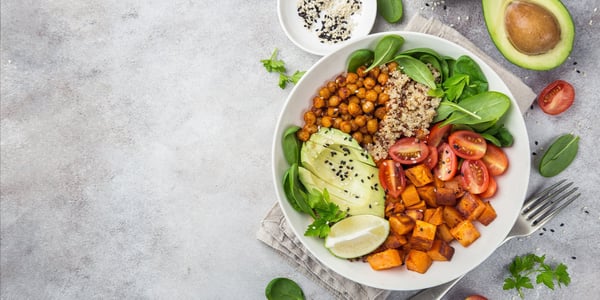Lunch in a restaurant is healthier than home lunch
Categories: Employer Tips for using benefits Merchant

Before the corona virus, a good 40% of employees enjoyed a workplace lunch in a restaurant every day, but during the corona virus, the number fell by 8%. Nowadays, almost 70% of those who work remotely prepare lunch themselves. Home-cooked lunch, however, most often does not meet nutritional recommendations. Its stumbling block is especially the amount of vegetables. According to the latest research results, only 14% of Finnish men and 22% of women reach the daily goal of half a kilo of vegetables. The goals are most easily met in lunch restaurants, which offer a rich salad table.
80 percent of Finns do not achieve the goal of ‘’a pound of vegetables a day’’
About 70 percent of people working from home now prepare their own lunch. Before the pandemic, just over 40 percent of employees enjoyed lunch at a restaurant every day, that number dropped to only 8 percent during the pandemic. So how does a home-cooked lunch affect our health?
At the end of the article, you will find two examples of different lunches with the same amount of energy, but very different nutritional values. You can jump to the examples directly here.
Only few succeed in the kitchen as well as would be recommended to maintain healthy eating habits. Especially vegetable intake is far too little. There is also too little fiber in the home lunch, and too much saturated fats.
"A homemade lunch loses in its nutritional value to almost every restaurant lunch. The amount of energy an employee receives is often the same, but the differences in nutritional value are staggering. In a balanced restaurant lunch, for example, the amount of fiber can be half that of the home option. There are also big differences in vitamins", says Laura Kuusela, Edenred Finland's Director of sustainability.
At the end of the text is an example of a good lunch and a regular home lunch.
"14% of men and 22% of women don’t eat enough vegetables. The recommended daily vegetable intake is one pound per day. Men in particular benefit from eating lunch at a restaurant. Men who eat at a restaurant already get as many vegetables from lunch as other men get all day, Kuusela says.
The data appear from the FinnRavinto2017 survey conducted every five years, the last results were published in 2019.
Stress causes snacking
During the pandemic, 80 percent of employees spent at least half of their working time remotely.
"One-third of the day is spent asleep, one-third is working and one-third is free time. As part of the working time moves inside the walls of your home, the nature of being at home will change", Kuusela says.
A study published by the University of Helsinki in October 2021, which is part of the international Corona Cooking Survey, reveals that the pandemic has increased the challenge factor for remote workers to make a nutritious lunch.
"The pandemic increased snacking. 30 percent of people had an increase in the consumption of sweet snacks. The consumption of savory snacks increased by a fifth. Remote working was also associated with a decrease in the use of vegetables and an increase in the use of savory snacks", Kuusela says.
The mental strain experienced by people is associated with a higher probability of consuming sweet snacks, sugary drinks, and alcoholic beverages.
" As remote work increases and social contacts decrease, the risk of unhealthy eating increases", Kuusela says.
The plate model works - pasta and ketchup aren’t enough
Do you remember the plate model you are familiar with from school? Time has not passed the plate model, as the model makes it easy to prepare a nutritious lunch. Half of the plate is filled with vegetables. Potatoes make up about a quarter of the plate. Instead of potatoes, you can eat rice, pasta, or other good carbohydrates.
About a quarter of the plate is left over for fish, meat, or egg foods, which can be replaced with vegetarian food containing legumes, nuts, or seeds. Drink skim milk, buttermilk, or water. In addition, the meal includes whole meal bread topped with a thin, soft vegetable oil spread. Berries or fruit as a dessert complement the meal. Dairy products and desserts can also be left to eat as a snack.
A suitable lunch size is about one-third of the energy requirement of the day. For an female office worker, this means about 600 kilocalories.
-"When people take a proper break and eat a nutritious lunch, they feel more energized at work. The fact that Edenred's lunch benefit can also be used to buy warm meals from the grocery store, as well as meals prepared by restaurants, increases the choice for lunches on remote working days as well. There are about 17,000 restaurants that accept lunch benefits so, it's no wonder that lunch benefit is the most popular employee benefit in Finland", Laura Kuusela, Edenred's Director of Sustainability.
Tips for a healthy and nutritious lunch
1. Keep white grains to the minimum
Prefer whole grains. It contains all the edible parts of the grain, the kernel, the germ, the interlayers, and the husk. Whole grain products contain all the nutrients in the different parts of the grain: the fibers in the husk, the nutrients in the kernel energy and the germ, the minerals, and the vitamins. Make sure the bread, porridge, pasta, and rice you use are made from whole grains.
2. Eat red and processed meat carefully.
Eat fish at least 1-2 times a week. Eating a lot of meat is harmful to the intestines, among other things. A reasonable weekly dose of meat is half a pound.
3. One tomato a day is not enough for vegetables
Vegetables, legumes, mushrooms, fruits, and berries should be eaten one pound per day or 5-6 servings: Half of this should be berries and fruits, and the other half vegetables and vegetables. One serving is a fruit, a cup of berries, or a cup and a half of salad. Vegetables are rich in fiber, vitamins, and minerals. Beans, lentils, and peas are quite high in protein and serve as a good source of protein for both mixed and vegetarians.
4. Beware of hidden fat and sugar
In the store, read the product descriptions, in the lunch restaurant, choose a heart brand option whenever one is available. Many sauces, juices, and yogurts are high in sugar. Hidden fat is usually in sausages, cheeses, and potato chips.
5. Do not fry or spread with butter
Prefer vegetable oil and plant-based spreads. Vegetable oils are therefore rich in polyunsaturated fatty acids. Saturated fatty acids increase the amount of harmful LDL cholesterol in the blood, while polyunsaturated fatty acids have been found to lower total cholesterol.
Don't skip lunch
A regular food rhythm reduces snacking and helps keep weight under control.
Sources: the Finnish institute of health and welfare.
Two example lunches - the same amount of energy, different amount of nutrition
Below are two sample lunches and their nutritional value. The options developed by the State Nutrition Advisory Board have the same amount of energy, but Lunch No. 1 provides more vitamins, minerals, and fiber than Lunch No. 2. Fish lunch also provides a lot of essential omega-3 fatty acids. The quality of the fat is also clearly better in the first option compared to the pasta lunch.
Lunch 1
60 g grated carrots
200 g mixed salad (tomato, lettuce, paprika, cucumber)
Oil-based sauce 15 g
Salmon fillet 100 g
2 medium boiled potatoes
1 medium apple
Nutritional content:
Energy 591 kcal
Protein 29 g
Carbohydrates 52 g
Fat 26 g, saturated 4 g
Vitamin D 10 µg
Vitamin C 100 mg
Fiber 9 g
Otherwise, the same for chicken fillet (120 g)
Energy 570 kcal
Fat 16 g, saturated fat 2.4 g
Protein 46 g
Vitamin C 100 mg
Fiber 9 mg
Lunch 2
400 g pasta and meat casserole (store-bought)
2 dl skim milk
50 g of cucumber
1 medium tomato
Nutritional content:
Energy 680 kcal
Protein 40 g
Carbohydrates 84 g
Fat 18 g, saturated fatty acids 8.5 g
Vitamin C 26 mg
Vitamin D 2.3 mg
Fiber 4.5 g
Calculation: Satu Jyväkorpi, State Nutrition Advisory Board / Special Expert






